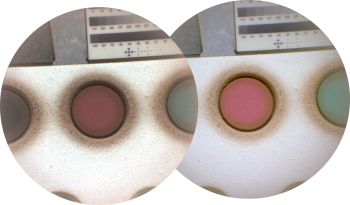
Geologists consider it crucial to work on faithful images of Mars. However, no color correction is yet done systematically on those images, especially due to the poor knowledge of the local martian weather. The weather is highly fluctuating and with the low gravity of the planet, it tends to set the conditions for varying amounts of dust in the atmosphere and ground illumination variations as well. Low discrimination of light variations by the Human Visual System is explained by Chromatic Adaptation (CA). Color images processing therefore often accounts for a step related to CA. This study investigates whether this step has to be applied to Mars images as well and is done through an illumination discrimination task performed on 15 observers for stimuli along daylight locus and solight locus (lights of Mars planet) generated through a 7-LEDs lighting system. This study gives outputs in agreement with other on daylight locus while showing low differences between results under daylight and solight.
Emilie Robert, Che Shen, Magali Estribeau, Edoardo Cucchetti, Mark Fairchild, "Color Correction of Mars Images: A Study of Illumination Discrimination Along Solight Locus" in Journal of Imaging Science and Technology, 2023, pp 1 - 9, https://doi.org/10.2352/J.ImagingSci.Technol.2023.67.5.050410
- received May 2023
- accepted August 2023
- PublishedSeptember 2023
| (a) Solight locus | (b) Daylight locus | ||
|---|---|---|---|
| CCT (K) | ΔEu′v′ | CCT (K) | ΔEu′v′ |
| 5400 | 0 | 6500 | 0 |
| 5300 | 0.0019 | 6325 | 0.0034 |
| 5200 | 0.0039 | 6125 | 0.0066 |
| 5100 | 0.0057 | 5937.5 | 0.0097 |
| 5000 | 0.0076 | 5750 | 0.0126 |
| 4900 | 0.0094 | 5562.5 | 0.0153 |
| 4800 | 0.0112 | 5375 | 0.0179 |
| 4700 | 0.0127 | 5187.5 | 0.0204 |
| 4600 | 0.0143 | 5000 | 0.0227 |
 Find this author on Google Scholar
Find this author on Google Scholar Find this author on PubMed
Find this author on PubMed
 Open access
Open access